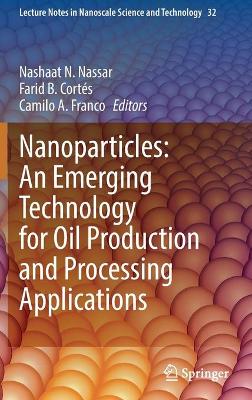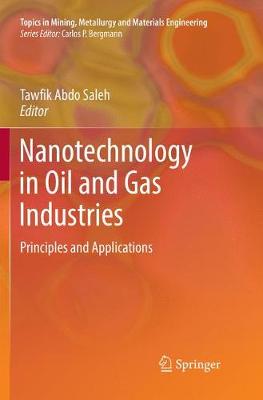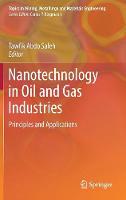Nanoparticles: An Emerging Technology for Oil Production and Processing Applications
 -15%
portes grátis
-15%
portes grátis
Nanoparticles: An Emerging Technology for Oil Production and Processing Applications
Cortes, Farid B.; Nassar, Nashaat N.; Franco, Camilo A.
Springer International Publishing AG
02/2022
518
Dura
Inglês
9783319120508
15 a 20 dias
945
Descrição não disponível.
Chapter 1. Nanoparticle Preparation, Stabilization and Control over Particle Size.- Chapter 2. Nanoparticles as Potential Agents for Enhanced Oil Recovery.- Chapter 3. Nanoparticles as Adsorbents for Asphaltenes.- Chapter 4. Nanoparticles as catalyst for asphaltenes and waste heavy hydrocarbons upgrading.- Chapter 5. Effect of Pressure on Thermo- and Thermocatalytic Oxidation of Asphaltenes.- Chapter 6. Nanoparticles for Heavy Oil Upgrading.- Chapter 7. Nanotechnology Applications for Viscosity Reduction of Heavy and Extra-Heavy Oils: A Review.- Chapter 8. Using Nanoparticles as Gas Foam Stabilizing Agents for Enhanced Oil Recovery Applications .- Chapter 9. Influence of Surfactant Adsorption on Surface-Functionalized Silica Nanoparticles For Gas Foam Stability.- Chapter 10. Nanoparticles for Drilling, Cementing, Hydraulic Fracturing and well stimulation Fluids .- Chapter 11. Double Purpose Drilling Fluid Based on Nanotechnology: Drilling-Induced Formation Damage Reduction and Improvement in Mud Filtrate Quality .- Chapter 12. Evaluation from Laboratory to Field Trial of Nanofluids for CaCO3 Scales Inhibition in Oil Wells.- Chapter 13. Removal of Uranium-238 from Flowback Water of Hydraulic Fracturing Processes in Unconventional Reservoirs using Phosphorus- and Nitrogen-Functionalized Activated Carbons.- Chapter 14. Nanopaticles for cleaning up Oil Sand Process-affected Water.- Chapter 15. Challenges and Uncertainties of Using Nanoparticles in Oil and Gas Applications.
Este título pertence ao(s) assunto(s) indicados(s). Para ver outros títulos clique no assunto desejado.
Application of Nanofluids;Cracking and Gasification of Asphaltenes;Determination of Reservoir Saturations;Environmental Applications of Nanoparticles;Eor/Ior;Formation Damage Remediation;Heavy Oil Upgrading;Nanotechnology in Oil Industry;Recovery Enhancement;Remediation of Oil Spills;Wettability Alteration
Chapter 1. Nanoparticle Preparation, Stabilization and Control over Particle Size.- Chapter 2. Nanoparticles as Potential Agents for Enhanced Oil Recovery.- Chapter 3. Nanoparticles as Adsorbents for Asphaltenes.- Chapter 4. Nanoparticles as catalyst for asphaltenes and waste heavy hydrocarbons upgrading.- Chapter 5. Effect of Pressure on Thermo- and Thermocatalytic Oxidation of Asphaltenes.- Chapter 6. Nanoparticles for Heavy Oil Upgrading.- Chapter 7. Nanotechnology Applications for Viscosity Reduction of Heavy and Extra-Heavy Oils: A Review.- Chapter 8. Using Nanoparticles as Gas Foam Stabilizing Agents for Enhanced Oil Recovery Applications .- Chapter 9. Influence of Surfactant Adsorption on Surface-Functionalized Silica Nanoparticles For Gas Foam Stability.- Chapter 10. Nanoparticles for Drilling, Cementing, Hydraulic Fracturing and well stimulation Fluids .- Chapter 11. Double Purpose Drilling Fluid Based on Nanotechnology: Drilling-Induced Formation Damage Reduction and Improvement in Mud Filtrate Quality .- Chapter 12. Evaluation from Laboratory to Field Trial of Nanofluids for CaCO3 Scales Inhibition in Oil Wells.- Chapter 13. Removal of Uranium-238 from Flowback Water of Hydraulic Fracturing Processes in Unconventional Reservoirs using Phosphorus- and Nitrogen-Functionalized Activated Carbons.- Chapter 14. Nanopaticles for cleaning up Oil Sand Process-affected Water.- Chapter 15. Challenges and Uncertainties of Using Nanoparticles in Oil and Gas Applications.
Este título pertence ao(s) assunto(s) indicados(s). Para ver outros títulos clique no assunto desejado.
Application of Nanofluids;Cracking and Gasification of Asphaltenes;Determination of Reservoir Saturations;Environmental Applications of Nanoparticles;Eor/Ior;Formation Damage Remediation;Heavy Oil Upgrading;Nanotechnology in Oil Industry;Recovery Enhancement;Remediation of Oil Spills;Wettability Alteration







